Important dates for the Second Generation of Romantics
Wollstonecraft (1759-1797), Blake (1757-1827), W. Wordsworth (1770-1850), D. Wordsworth (1771-1855), Coleridge (1772-18534), Byron (1788-1824), Mary Prince (1788-after 1833), P.B. Shelley (1792-1824), Mary Shelley (1797-1851), Felicia Hemans (1793-1835), John Keats (1795-1821)

The Napoleonic Wars
The War with France: at war for about 22 years, nearly Percy Shelley’s entire life
1793-1802; brief period of peace, 1803-1814, and 1815 (Napoleon’s hundred days and Waterloo)
Napoleon’s rise to power begins when he helps to establish a stable government in mid-1790s; appointed General in 1795; the Italian Campaign of 1796; followed by the Egyptian Campaign (where he was stopped by Lord Horatio Nelson in the Battle of the Nile); invasion of Rome and Switzerland (1798); the Syrian Campaign (1799); and the crossing of the Alps to attack Austria (1800)
1802 Napoleon declares himself Consul for Life after the brief Peace of Amiens
1803 War resumes
1804 Napoleon declares himself Emperor; revives absolute monarchy; for the next nine years there is constant battle between France and the allied forces which included England as the leader; initiates a constant back and forth of power and victory, although England is increasingly successful at sea with Nelson (until death in 1805) and on land with Wellington (who drives France from Spain).
1806 Byron publishes Fugitive Pieces
1807 Byron’s Hours of Idleness and WW’s Poems in Two Volumes (i.e. “I wandered
lonely as a cloud,” “London, 1802,” “Resolution and Independence,” “Elegiac Stanzas”
1810 Shelley publishes his first work (some poetry; slim Gothic novels)
1811 George III of England declared insane; his son becomes Prince Regent; Shelley expelled from Oxford; Austen publishes Sense and Sensibility
1812 Byron publishes Childe Harold’s Pilgrimage I and achieves instant notoriety
1813 Napoleon in full retreat; WW becomes Distributor of Stamps and Southey becomes Poet Laureate after Scott turns it down; Byron increasingly popular with “Oriental tales”; Shelley publishes “Queen Mab”
1814 Napoleon banished to Elba; the Congress of Vienna reestablishes monarchies; Napoleon escapes and has his 100 days; defeated at Waterloo in 1815; Mary Godwin and Percy Bysshe Shelley run away together to France during the brief period of peace
1815 Waterloo
1816 “The Year without a Summer”: Mary Godwin, and Claire Clairmont leave for Switzerland; the Geneva Spring where Byron joins them; Byron writes Childe Harold’s Pilgrimage III even as Coleridge publishes “Christabel, Kubla Khan, and the Pains of Sleep”; Austen’s Emma; PB Shelley’s Alastor, and Other Poems (including “To Wordsworth”)
1817 Period of great political and economic turmoil; again Habeas Corpus is suspended and democratic societies are forbidden; Rioting at Spa Fields; Coleridge publishes Biographia Literaria and Sibylline Leaves; Keats publishes his first volume of Poems
Death of Austen
1818 Austen’s posthumous Persuasion; publication of Mary Shelley’s Frankenstein
1819 Peterloo Massacre; Don Juan (without its “Dedication”)
1820 Death of George the III; the Regent becomes King; great year of publication for Keats (“Eve of St. Agnes” volume, including Odes); PB Shelley, The Cenci; WW The River Duddon, A Series of Sonnets; Death of Keats
1821 Publication of Percy Bysshe Shelley’s “Adonais”; more of Don Juan
1822 Death of Shelley
1824 Death of Byron; Mary Shelley edits and publishes first edition of Shelley’s Posthumous Poems
1826 Hemans’ “To the Poet Wordsworth”
1828 Hemans’ Records of Woman
1833 Publication of the Dedication to Don Juan
1834 Death of Coleridge
1835 Death of Hemans
1850 Death of William Wordsworth
1855 Death of Dorothy Wordsworth